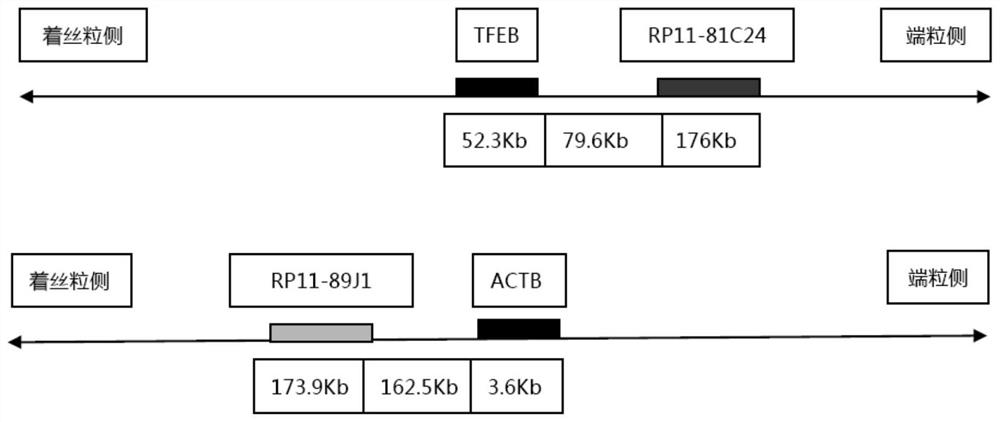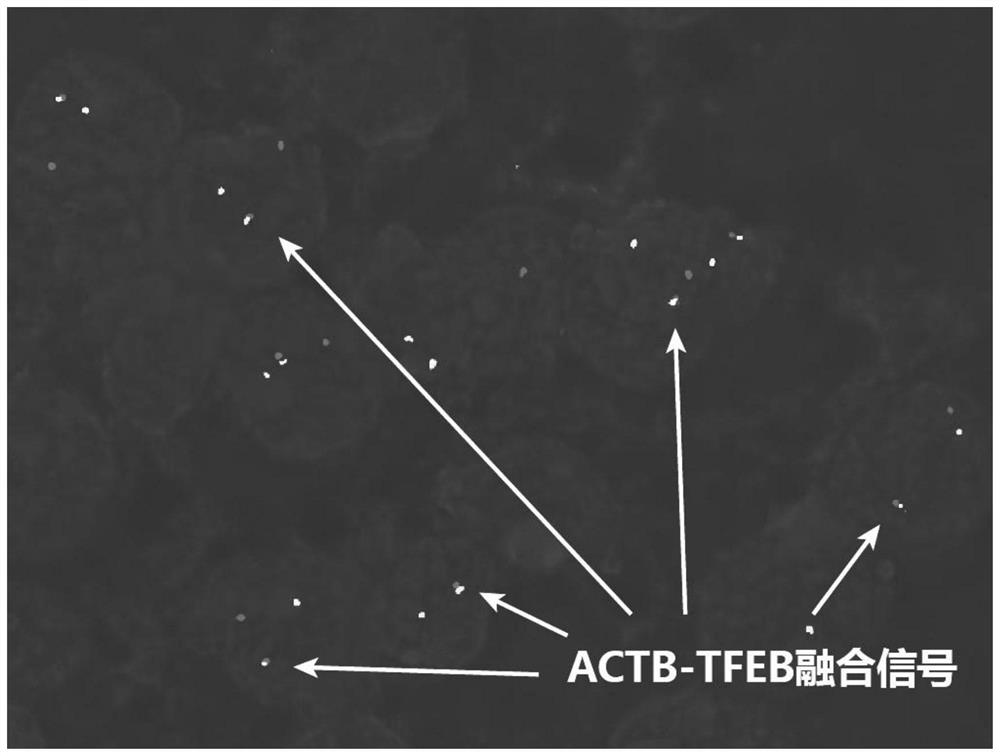A probe combination and its application for diagnosing actb-tfeb translocation renal carcinoma
A probe, kidney cancer technology, applied in the field of fluorescence in situ hybridization probe application, can solve the problem of no report, and achieve the effect of improving the accuracy and reliable success rate
- Summary
- Abstract
- Description
- Claims
- Application Information
AI Technical Summary
Problems solved by technology
Method used
Image
Examples
Embodiment 1
[0036] Embodiment 1 is verified for the case of definite diagnosis:
[0037] For kidney cancer cases in which new fusion sites of ACTB exon3-TFEB exon2 were detected by high-throughput sequencing RNA-seq, the primers we designed were used for verification.
[0038] 1. Extraction of RNA:
[0039] Strictly follow the RNeasy FFPE Kit operating instructions for extraction. ① Dewaxing: dewax the collected slides with xylene, rinse with absolute ethanol, air-dry and scrape off with a scalpel blade and put them into a 1.5ml EP tube; Proteinase K, mix well, enzymatically digest at 56°C for 15min, then at 80°C for 15min, cool on ice; ③add 16μl DNase buffer, then add 10μl DNase I, mix well, let stand at room temperature for 15min, centrifuge at 12000rpm for 15min, and take the supernatant;④ Add 320μl of binding solution and 720μl of absolute ethanol, mix well, transfer to the adsorption column twice, centrifuge at 8000rpm for 1min, discard the waste liquid; ⑤Wash: add 500μl of washing...
Embodiment 2
[0043] Embodiment 2: the preparation of DNA probe combination:
[0044] Select two BAC clone fragments that can be connected on the telomeric side of the TFEB gene on chromosome 6 and the centromere side of the ACTB gene on chromosome 7, control the longest distance between the probes at both ends within 1500kb, and keep the distance between the BAC clone fragments A certain distance does not overlap, and the fragments are similar in size. The cloned fragments were obtained from the Human BAC Cloning Center of EmpireGenomics (http: / / www.empiregenomics.com / helixhq / clonecentral / search / human). The BAC clone probe on the centromere side of ACTB is RP11-89J1 (fragment length 173.9kb), and the BAC clone probe on the TFEB telomeric side is RP11-81C24 (fragment length 176kb). These fragments are Bacterial artificial chromosomes, BAC) clone, its location on human chromosomes has been published, respectively, RP11-89J1 is located on chromosome 7 5190772-5364691, and RP11-81C24 is locat...
Embodiment 3
[0046] Embodiment 3: fluorescence in situ hybridization process:
[0047] A case of ACTB-TFEB translocation renal carcinoma was diagnosed by high-throughput sequencing and RT-PCR detection of fusion genes ( figure 2 , corresponding to the results of this experiment can better reflect the reliability of this experiment), and two experienced pathologists referred to the WHO2016 urinary and male reproductive system classification standards, collected 30 cases of renal cell carcinoma diagnosed in Nanjing General Hospital of Nanjing Military Region as control group.
[0048] Wax blocks were sliced at a thickness of 3 μm. After dewaxing, they were placed in 100%, 85%, and 70% ethanol for 2 minutes each, and then immersed in deionized water for 15 minutes in a water bath at 100°C. Put the tissue slices into pepsin K solution (0.1g pepsin, 40ml 0.01M HCL) at 37°C for 15min; rinse twice with 2×SSC (sodium chloride, sodium citrate) for 5min each, and place the slices in 0.1mol / L So...
PUM
 Login to View More
Login to View More Abstract
Description
Claims
Application Information
 Login to View More
Login to View More - R&D
- Intellectual Property
- Life Sciences
- Materials
- Tech Scout
- Unparalleled Data Quality
- Higher Quality Content
- 60% Fewer Hallucinations
Browse by: Latest US Patents, China's latest patents, Technical Efficacy Thesaurus, Application Domain, Technology Topic, Popular Technical Reports.
© 2025 PatSnap. All rights reserved.Legal|Privacy policy|Modern Slavery Act Transparency Statement|Sitemap|About US| Contact US: help@patsnap.com



